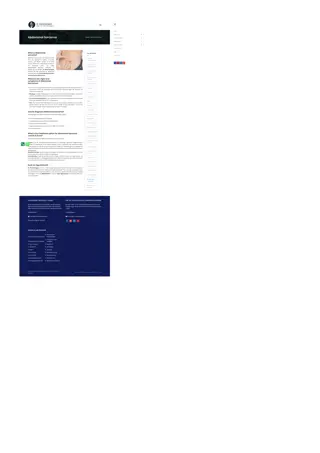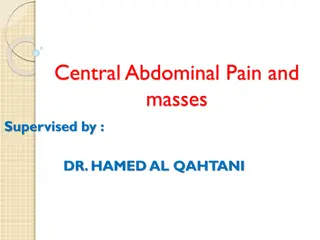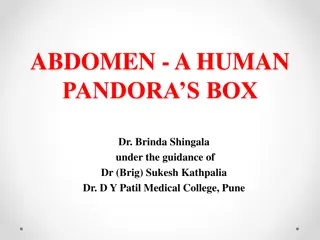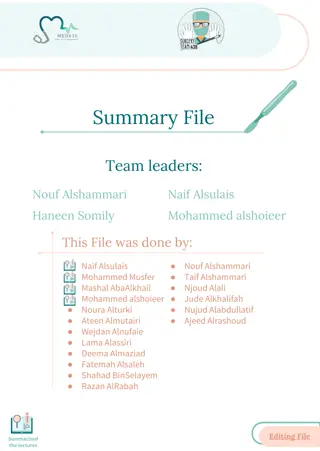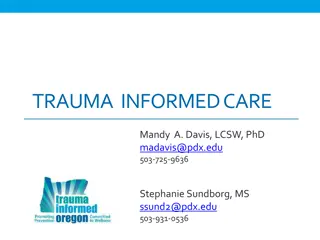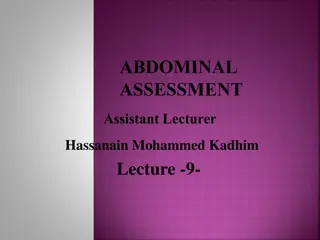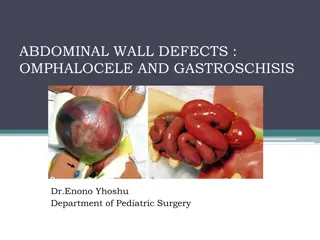Understanding Abdominal Trauma: Epidemiology, Mechanism, Evaluation & Management
Abdominal trauma is a significant concern, notably in road traffic accidents. Blunt abdominal trauma (BAT) accounts for a majority of cases, with injuries commonly affecting the spleen and liver. Various mechanisms of injury and evaluation techniques, including examination signs and lab tests, aid in diagnosing and managing these injuries effectively. Imaging modalities like CT scans play a crucial role in determining the extent of injury and the need for surgical intervention.
Download Presentation

Please find below an Image/Link to download the presentation.
The content on the website is provided AS IS for your information and personal use only. It may not be sold, licensed, or shared on other websites without obtaining consent from the author. Download presentation by click this link. If you encounter any issues during the download, it is possible that the publisher has removed the file from their server.
E N D
Presentation Transcript
BAT 1
Epidemiology BAT accounts for 80% of the abdominal trauma 75% related to RTC Blows to abdomen and falls - 15% & 6-9% Prevalence is 13% Spleen & Liver most commonly injured
Mechanism of Injury Intra-abdominal pressure outward can rupture a hollow vis Lap belt without a shoulder attachment compresses the abd Force against the anterior abd wall can lead to vertebral injury Deceleration injuries can cause hollow Vis, tear vascular pedicle - kidney commonly injured Fracture of ribs or pelvic bone can lacerate intra-abdominal tissues
History Fatality at scene Vehicle type & speed Vehicle rolled over (seat position of impact ) Extent of intrusion ( >6 inches ass with increased injury) Extent of damage to the vehicle Steering wheel deformity Seat belt used if so what type Airbags
Examination Seat Belt sign (LR 5.6-9.9) Rebound tenderness ( LR 6.5) Hypotension (LR 5.2) Abdominal distension (LR 3.8) Abdominal Guarding ( LR 3.7) Femur fracture (LR 2.9) 10% with isolated HI may have abdominal injury 7% with no pain or tenderness but has distracting injury may have AT
Examination Pain in the left costal margin is associated with splenic injury in 5.6% 90% of Patients with visceral injury with no distracting injuries will present with pain and tenderness Awake, no distracting injury no findings on abdominal examination very unlikely to have any abdominal injuries Think about referred pain Seat belt sign - 1/3 will have abdominal injury
Lab test Haematocrit - <30% increase Likely hood (LR 3.3) Leucocyte count Pancreatic enzyme LFT - Raised LT (LR 2.5-5.2) Urine analysis - Microscopic H (LR 3.4-7.4) Base deficit & lactate - BE of -6 was ass with intra-intra- abd injury & need for laparotomy & transfusion
CT Sensitivity & Specificity- 97-98% & 97-99% Pt with BAT & negative MDCT - chances of injury low (0.06%) LR 0.034 In a study of 5000 pts only 5% had injury which needed surgery
Management Haemodynamically unstable patient Hamedynamically Stable patient
Indication for Laparotomy Unexplained blood loss or hypotension who cannot be stabilised Persistent signs of irritation Evidence of pneumoperitoneum consistent with viscus rupture Diaphragmatic rupture GI bleed which is persistent
Special Consideration Pelvic Fracture Multiple system injury Closed Head Injury Transfers Pregnant patient Geriatric Patient







